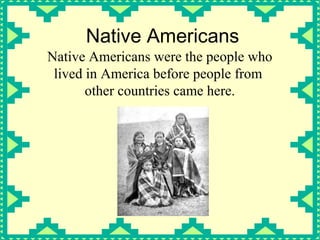
Native Americans Adapted to Regions and Resources
- 1. Native Americans Native Americans were the people who lived in America before people from other countries came here.
- 2. Native Americans respected nature. They took care of the earth and only used what they needed.
- 3. Native Americans used natural resources to meet their needs. trees water stones buffalo Natural resources are things in nature that people can use.
- 4. Native Americans lived in culture groups. The people in a culture group have the same way of life. A culture group is a group of people who live in the same region.
- 5. Native Americans lived in six different regions.
- 6. Each region had different physical surroundings. Some regions had forests. Others were mostly desert.
- 7. Still others had oceans nearby.
- 8. Each region had different natural resources. Each culture group used the natural resources in its region to meet its needs.
- 9. For this reason, Native American culture groups had different homes. Those who lived near deserts used clay or stones to build their homes. Those who lived on the Plains used buffalo skins to make their homes. Still others lived near forests. They built their homes of wood.
- 10. Many Native American culture groups built their homes in villages or cities. These are the remains of an ancient Anasazi cliff village.
- 11. Other culture groups, like the Plains Indians, were nomadic. They could not live in one place. They had to move around to follow the buffalo.
- 12. The physical surroundings of each region also affected how each culture group got its food. Native Americans in the Eastern Woodlands were very lucky. That region had forests, lakes and rivers, a nearby ocean, and good climate. These Native Americans could farm, hunt, and fish for food.
- 13. There were no forests in the Southwest region. The land was rocky and uneven. There were many mesas, or large rocks with flat tops. The Indians who lived in this region were farmers. They planted their crops on the tops of mesas.
- 14. Native Americans in the California Intermountain region were known as gatherers.
- 15. There were few natural resources in this region. These Native Americans gathered acorns, seeds, and fruits. They also dug up plant roots to eat for food.
- 16. Indians from the Northwest Coast hunted sea animals in the Pacific Ocean. There were many salmon in the rivers for them to eat. They also hunted animals in nearby forests.
- 17. Buffalo were a natural resource in the Plains region. The meat was used for food. The skins were used for shelters and clothing. The bones were used for tools.
- 18. The physical surroundings of the regions affected each culture group’s way of life in other ways, too. There was much clay in the Southwest. Native Americans that lived in this region used the clay to make beautiful pottery.
- 19. The Northwest Coast region had many forests. The Native Americans in this region used wood from the forests to carve tall totem poles. The carvings on each totem pole told about a family’s history.
- 20. There were many buffalo in the Plains region. Native Americans who lived in this region were hunters. The Plains Indians had special ceremonies before big hunts. They danced to the music of drums. They thought this would bring them good luck on the hunt.
- 21. Native Americans in the California Intermountain region were expert basket weavers. They made beautiful baskets out of grasses and plants.
- 22. Physical surroundings affected how the Indians traveled, too. All Indians walked. Plains and Southwest Indians got horses from Spanish explorers. Indians in the Eastern Woodlands, Northwest Coast, and California Intermountain regions used canoes.
- 23. Iroquois Social Song Cherokee War Dance Apache War Song Navajo Flute
- 25. Let’s review. We know: Native Americans were the first Americans. Native Americans respected nature. Native Americans used natural resources. Native Americans lived in different regions. Native Americans had different homes. Native Americans got food in different ways. Native American culture groups had different ways of life due to their different physical surroundings and natural resources.
- 26. 1. Natural resources are a. things people play with b. things in nature people can use c. Quiz things people can buy at a store 2. What did each tribe use to help meet their needs? a. money b. food c. natural resources 3. All Native Americans lived in tee-pees. a. True b. False 4. What does nomadic mean? a. moving around b. staying in one place c. having no place to live 5. What animal did the Native Americans who lived on the Plains depend on most? a. horses b. cow c. buffalo
- 27. Quiz 6. Some Native Americans gathered acorns and roots to eat . a. True b. False 7. What did the pictures on totem poles tell about? a. How many buffalo a tribe killed b. A families history c. What type a house a tribe lived in 8. Why did the Native Americans who lived on the Plains dance before a big hunt? a. They thought it would bring them good luck. b. They thought it would attract the buffalo c. They liked to dance and have fun 9. How did ALL Native Americans travel? a. They road horses b. They traveled in canoes c. They walked 10. Native American culture groups had different ways of life due to their different physical surroundings and natural resources. a. True b. False